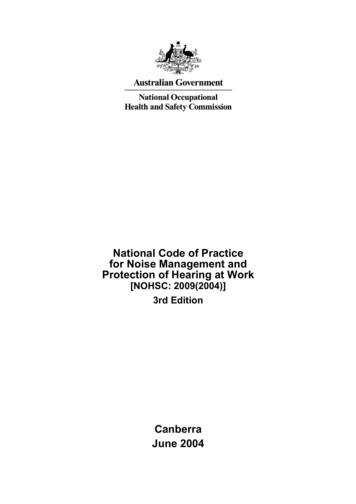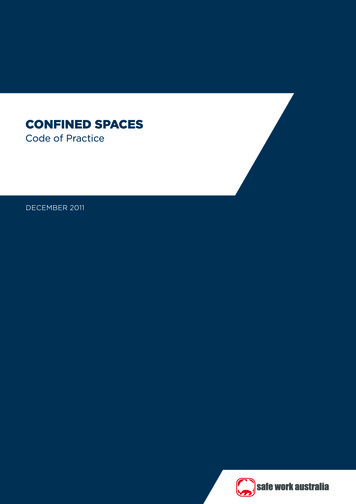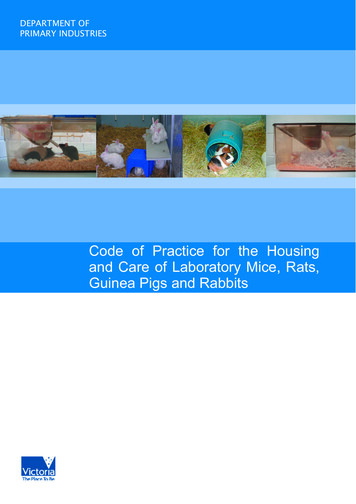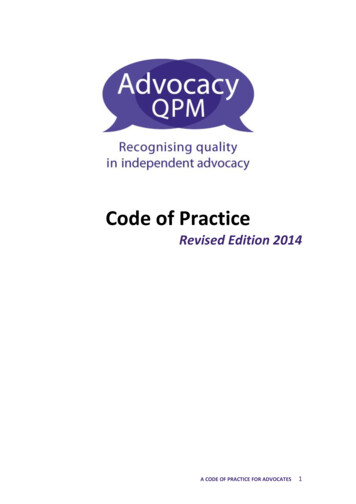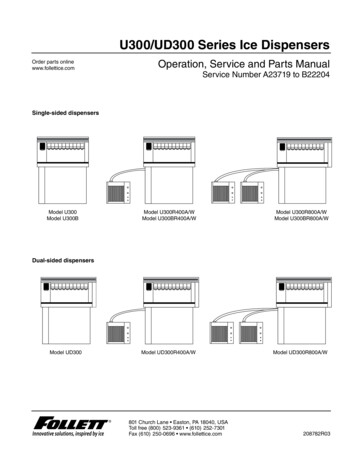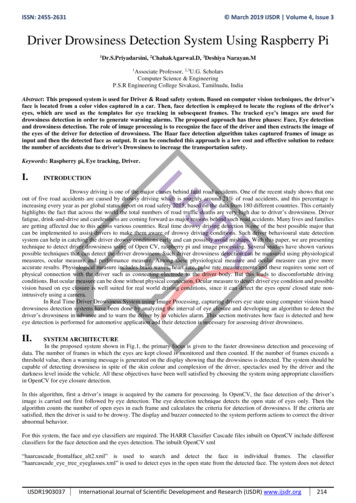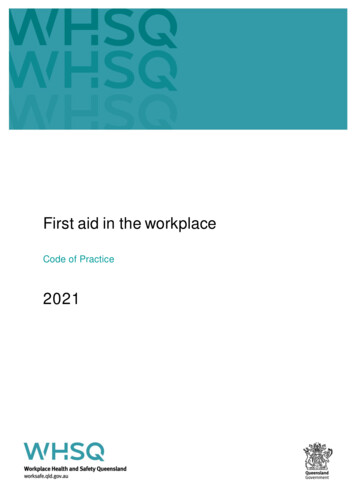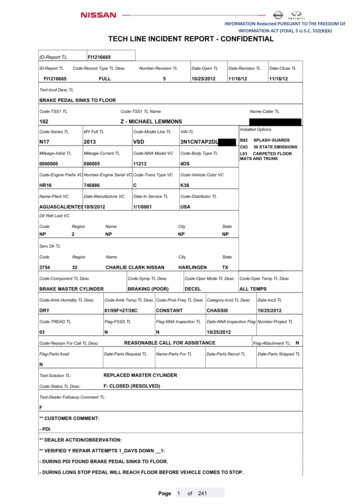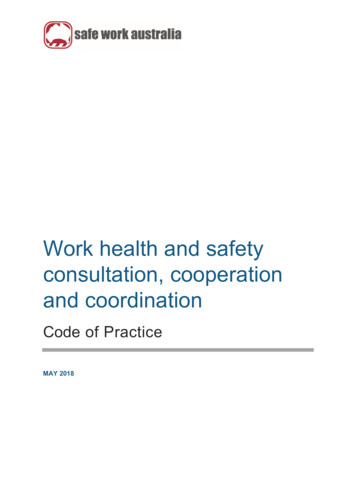
Transcription
Work health and safetyconsultation, cooperationand coordinationCode of PracticeMAY 2018
DisclaimerSafe Work Australia is an Australian Government statutory agency established in 2009. Safe Work Australia includes Membersfrom the Commonwealth, and each state and territory, Members representing the interests of workers and Membersrepresenting the interests of employers.Safe Work Australia works with the Commonwealth, state and territory governments to improve work health and safety andworkers’ compensation arrangements. Safe Work Australia is a national policy body, not a regulator of work health and safety.The Commonwealth, states and territories have responsibility for regulating and enforcing work health and safety laws in theirjurisdiction.ISBN 978-0-642-33299-8 (PDF)ISBN 978-0-642-33300-1 (DOCX)Creative CommonsThis copyright work is licensed under a Creative Commons Attribution-Noncommercial 4.0 International licence. To view a copyof this licence, visit creativecommons.org/licenses In essence, you are free to copy, communicate and adapt the work for noncommercial purposes, as long as you attribute the work to Safe Work Australia and abide by the other licence terms.Contact informationSafe Work Australia info@swa.gov.au www.swa.gov.au
ContentsForeword . 51. Introduction . 61.1.Who has duties in relation to work health and safety consultation, cooperationand coordination? . 61.2.Why is consultation important? . 82. When to consult with workers . 102.1.Managing work health and safety risks . 102.2.Deciding on welfare facilities . 112.3.Making changes affecting work health and safety. 112.4.Developing work health and safety procedures . 113. What is effective consultation? . 133.1.Sharing information . 133.2.Providing reasonable opportunities to express views and contribute . 143.3.Taking views into account . 143.4.Advising outcomes of consultation. 153.5.To what extent should you consult?. 153.6.Must consultation be documented? . 154. How to consult with workers . 174.1.What kind of consultation is best for your workplace?. 174.2.Agreeing on consultation procedures . 184.3.Consulting using health and safety representatives and committees . 194.4.Sharing consultation arrangements with other duty holders . 214.5.How should the consultation arrangements be reviewed? . 225. When to consult, cooperate and coordinate activities with other duty holders . 235.1.Who must consult, cooperate and coordinate and with whom . 245.2.When must you consult, cooperate and coordinate with others? . 246. What is effective consultation with other duty holders? . 266.1.What is meant by cooperation? . 266.2.What is meant by coordination? . 276.3.What if another duty holder refuses to consult or cooperate or coordinate?. 27Appendix A–Glossary . 28Appendix B–Examples of consultation arrangements . 30Example 1: Consultation in a workplace with no health and safety representatives . 30Example 2: Consultation in a workplace with health and safety representatives . 31Appendix C–Consulting, cooperating and coordinating activities . 33Example 1: Sharing the same workplace. 33
Example 2: Sharing the same workers . 34Example 3: Running an event with other duty holders . 34Appendix D–Consultation checklist . 37Appendix E–Consultation requirements in the WHS Regulations . 39Amendments . 41Work health and safety consultation, cooperation and coordinationCode of PracticePage 4 of 41
ForewordThis Code of Practice on how to meet the requirements for consultation, cooperation andcoordination on work health and safety matters is an approved code of practice undersection 274 of the Work Health and Safety Act (the WHS Act).An approved code of practice provides practical guidance on how to achieve the standardsof work health and safety required under the WHS Act and the Work Health and SafetyRegulations (the WHS Regulations) and effective ways to identify and manage risks.A code of practice can assist anyone who has a duty of care in the circumstances describedin the code of practice. Following an approved code of practice will assist the duty holder toachieve compliance with the health and safety duties in the WHS Act and WHS Regulations,in relation to the subject matter of the code of practice. Like regulations, codes of practicedeal with particular issues and may not cover all relevant hazards or risks. The health andsafety duties require duty holders to consider all risks associated with work, not only thosefor which regulations and codes of practice exist.Codes of practice are admissible in court proceedings under the WHS Act and WHSRegulations. Courts may regard a code of practice as evidence of what is known about ahazard, risk, risk assessment or risk control and may rely on the code in determining what isreasonably practicable in the circumstances to which the code of practice relates. For furtherinformation see the Interpretive Guideline: The meaning of ‘reasonably practicable’.Compliance with the WHS Act and WHS Regulations may be achieved by following anothermethod if it provides an equivalent or higher standard of work health and safety thanthe code.An inspector may refer to an approved code of practice when issuing an improvement orprohibition notice.Scope and applicationThis Code is intended to be read by a person conducting a business or undertaking (PCBU).It provides practical guidance to PCBUs on how to effectively consult with workers who carryout work for the business or undertaking and who are (or are likely to be) directly affected bya health and safety matter. It includes information on mechanisms to facilitate workerparticipation and representation.This Code also provides guidance to PCBUs who share responsibility for the same workhealth and safety matter on how to consult, cooperate and coordinate activities with eachother.This Code may be a useful reference for other persons interested in the duties under theWHS Act and WHS Regulations.This Code applies to all workplaces covered by the WHS Act where work health and safetyconsultation, cooperation and coordination is required.How to use this Code of PracticeThis Code includes references to the legal requirements under the WHS Act and WHSRegulations. These are included for convenience only and should not be relied on in place ofthe full text of the WHS Act or WHS Regulations. The words ‘must’, ‘requires’ or ‘mandatory’indicate a legal requirement exists that must be complied with.The word ‘should’ is used in this Code to indicate a recommended course of action, while‘may’ is used to indicate an optional course of action.Work health and safety consultation, cooperation and coordinationCode of PracticePage 5 of 41
1. Introduction1.1. Who has duties in relation to work health andsafety consultation, cooperation andcoordination?Duty holders who have a role in either consultation, cooperation or coordination include: persons conducting a business or undertaking (PCBUs)designers, manufacturers, importers, suppliers and installers of plant, substances orstructures, andofficers.Workers and other persons at the workplace also have duties under the WHS Act, such asthe duty to take reasonable care for their own health and safety at the workplace.A person can have more than one duty and more than one person can have the same dutyat the same time.Early consultation and identification of risks can allow for more options to eliminate orminimise risks and reduce the associated costs.Person conducting a business or undertakingPCBUs have a duty to consult workers about work health and safety and may also haveduties to consult, cooperate and coordinate with other duty holders.Consulting workersWHS Act section 47Duty to consult workersA PCBU must consult, so far as is reasonably practicable, with workers who carry out workfor the business or undertaking and who are (or are likely to be) directly affected by a healthand safety matter.This duty to consult is based on the recognition that worker input and participation improvesdecision-making about health and safety matters and assists in reducing work-relatedinjuries and disease.The broad definition of a ‘worker’ under the WHS Act means a PCBU must consult withemployees and anyone else who carries out work for the business or undertaking. A PCBUmust consult, so far as is reasonably practicable, with contractors and subcontractors andtheir employees, on-hire workers, outworkers, apprentices, trainees, work experiencestudents, volunteers and other people who are working for the PCBU and who are, or arelikely to be, directly affected by a health and safety matter.Workers are entitled to take part in consultations and to be represented in consultations by ahealth and safety representative who has been elected to represent their work group.Work health and safety consultation, cooperation and coordinationCode of PracticePage 6 of 41
Consulting, cooperating and coordinating activities with other duty holdersWHS Act section 46Duty to consult with other duty holdersThe WHS Act requires a PCBU to consult, cooperate and coordinate activities with all otherpersons who have a work health or safety duty in relation to the same matter, so far as isreasonably practicable.There is often more than one business or undertaking with responsibility for the same healthand safety matters, either because they are involved in the same activities or share thesame workplace.In these situations, each duty holder should exchange information to find out who is doingwhat and work together in a cooperative and coordinated way so risks are eliminated orminimised so far as is reasonably practicable.Examples of where a PCBU will have a health and safety duty include where: the PCBU engages workers to carry out workthe PCBU directs or influences workers in carrying out workother persons may be put at risk from work carried out in their business or undertakingthe PCBU manages or controls a workplace or the fixtures, fittings or plant at aworkplacethe PBCU’s business or undertaking involves designing, manufacturing, importing orsupplying plant, substances or structures for use at a workplacethe PBCU’s business or undertaking involves installing, constructing or commissioningplant or structures at a workplace.Duty holders’ work activities may overlap and interact at particular times. When they share aduty, for example a duty in relation to the health and safety of the same worker or workers,or are involved in the same work, they will be required to consult, cooperate and coordinateactivities with each other so far as is reasonably practicable.Designers, manufacturers, importers and suppliers of plant,substances or structuresWHS Act Part 2 Division 3Further duties of persons conducting businesses or undertakingsDesigners, manufacturers, importers and suppliers of plant, substances or structures mustensure, so far as is reasonably practicable, the plant, substance or structure they design,manufacture, import or supply is without risks to health and safety. This duty includescarrying out testing and analysis as well as providing specific information about the plant orsubstance.To assist in meeting these duties, the WHS Regulations require: manufacturers to consult with designers of the plantimporters to consult with designers and manufacturers of plant, andthe person who commissions construction work to consult with the designer ofthe structure.Work health and safety consultation, cooperation and coordinationCode of PracticePage 7 of 41
Principal contractorsWHS Regulation 309WHS management plan—preparationThe principal contractor for a construction project has a specific duty under the WHSRegulations to document, in their WHS Management Plan for the project, the arrangementsin place for consultation, cooperation and coordination between the PCBUs at the site.OfficersWHS Act section 27Duty of officersOfficers, for example company directors, have a duty to exercise due diligence to ensure thePCBU complies with the WHS Act and WHS Regulations. This includes taking reasonablesteps to ensure the business or undertaking has appropriate processes for complying withthe duty to consult workers as well as the duty to consult, cooperate and coordinate withother duty holders. Further information on who is an officer and their duties is available in theInterpretive Guideline: The health and safety duty of an officer under section 27.WorkersWHS Act section 28Duties of workersWorkers have a duty to take reasonable care for their own health and safety and to notadversely affect the health and safety of other persons. Workers must comply withreasonable instructions, as far as they are reasonably able, and cooperate with reasonablehealth and safety policies or procedures that have been notified to workers, for exampleprocedures for consultation at the workplace.1.2. Why is consultation important?Consultation is a legal requirement and an essential part of managing health and safetyrisks.A safe workplace is more easily achieved when everyone involved in the workcommunicates with each other to identify hazards and risks, talks about health and safetyconcerns and works together to find solutions. This includes cooperation between dutyholders, the people who manage or control the work and those who carry out the work orwho are affected by the work.By drawing on the knowledge and experience of their workers, PCBUs can make moreinformed decisions about how the work should be carried out safely.Effective health and safety consultation also has other benefits: greater awareness and commitment—because workers who have been actively involvedin how health and safety decisions are made will better understand the decisionsWork health and safety consultation, cooperation and coordinationCode of PracticePage 8 of 41
positive working relationships—because understanding the views of others leads togreater cooperation and trust.In situations where a PCBU shares responsibility for health and safety with another person,the requirement to consult, cooperate and coordinate activities with other duty holders willhelp address gaps in managing health and safety risks that often occur when: there is a lack of understanding of how the activities of each person may add to thehazards and risks to which others may be exposedduty holders assume someone else is taking care of the health and safety matter, orthe person who takes action is not the best person to do so.Consulting, cooperating and coordinating activities with other duty holders assists each dutyholder understand how their activities may impact on health and safety and the actions eachduty holder takes to control risks are complementary.Work health and safety consultation, cooperation and coordinationCode of PracticePage 9 of 41
2. When to consult with workersMany organisational decisions or actions have health and safety consequences for workers.For example, introducing new equipment into the workplace may affect the tasks yourworkers carry out, the timeframes for doing work, how they interact with each other and theenvironment in which they work.The WHS Act identifies specific matters that trigger the requirement for consultation.WHS Act section 49When consultation is requiredAs a person conducting a business or undertaking (PCBU) you must consult with workerswhen: identifying hazards and assessing risks to health and safety arising from the work carriedout or to be carried outmaking decisions about ways to eliminate or minimise those risksmaking decisions about the adequacy of facilities for the welfare of workersproposing changes that may affect the health or safety of your workers, andmaking decisions about procedures for consulting with workers; resolving health orsafety issues at the workplace; monitoring health of your workers; monitoring theconditions at the workplace under your management or control and providing informationand training for your workers.However, it may be useful to also consult workers about matters not listed above.Requirements for consultation in the WHS Regulations are listed in Appendix E.Regular consultation is better than consulting only as issues arise on a case-by-case basisbecause it allows you to identify and fix potential problems early.2.1. Managing work health and safety risksConsultation is required when identifying hazards, assessing risks and deciding onmeasures to eliminate or minimise those risks.In deciding how to eliminate or minimise risks, you must consult with your workers who willbe affected by this decision, either directly or through their health and safety representative.Their experience may help you identify hazards and choose practical and effective controlmeasures. A duty holder must review control measures if consultations indicate a review isnecessary.Regularly walking around the workplace, talking to your workers and observing how work isdone will also help you identify hazards. Conducting a survey of your workers can providevaluable information about work-related health issues, for example workplace bullying,stress and muscular aches and pains that can signal potential hazards.Workers and their health and safety representatives may request access to information, forexample technical guidance about workplace hazards and risks associated with plant,equipment and substances. Information should not be withheld just because it is technical ormay be difficult to understand.Work health and safety consultation, cooperation and coordinationCode of PracticePage 10 of 41
The WHS Act requires you to allow health and safety representatives for a work group tohave access to information you have relating to hazards, including associated risks, affectingworkers in the work group and also information about the health and safety of workers in thework group. This does not extend access to personal or medical information that identifies orcould reasonably lead to the identification of a worker without the worker’s consent.Further guidance on risk management is available in the Code of Practice: How to managework health and safety risks.2.2. Deciding on welfare facilitiesFacilities are things provided for the welfare of workers, for example toilets, drinking water,washing facilities, eating facilities, change rooms, personal storage and first aid.You must consult your workers when making decisions about what facilities are needed (forexample the number and location of toilets), taking into consideration the number andcomposition of your workforce, the type of work your workers do, the nature of the hazards inthe workplace and the size and location of your workplace. The consultation should includeaccess, cleaning and maintenance of the facilities.If the facilities are already provided at the workplace, you should consult your workers andtheir health and safety representatives when there are changes affecting the adequacy ofthe facilities. This will help you determine if you should change or expand your facilities.Further guidance is available in the Code of Practice: Managing the work environment andfacilities.2.3. Making changes affecting work health andsafetyYou must consult your workers when proposing changes that may affect their work healthand safety. Some examples of when consultation would be required include when you areproposing to: change work systems such as shiftwork rosters, work procedures or the workenvironmentdevelop a new product or plan a new projectpurchase new or used equipment or use new substances, orrestructure the business.2.4. Developing work health and safetyproceduresA procedure sets out the steps to be followed for work activities. You must consult withaffected workers when developing procedures for: consulting with workers on work health and safetyresolving work health and safety issuesmonitoring workers’ health and workplace conditions, andproviding information and training for workers.Work health and safety consultation, cooperation and coordinationCode of PracticePage 11 of 41
Procedures should be in writing to provide clarity and certainty at the workplace and assist indemonstrating compliance. They should clearly set out the role of health and safetyrepresentatives, both legislative and workplace specific, and other parties involved in theactivity. The procedures should be easily accessible, for example by placing them onnoticeboards and intranet sites.Developing issue resolution proceduresThe WHS Regulations set out default issue resolution procedures which you must followunless you choose to develop your own procedures. If you choose to develop your ownprocedures, you must follow the minimum requirements and steps set out in the WHS Actand WHS Regulations. These include setting out your procedures in writing andcommunicating the procedures to all workers they cover.Work health and safety consultation, cooperation and coordinationCode of PracticePage 12 of 41
3. What is effective consultation?Consultation is a two-way process between you and your workers where you: talk to each other about health and safety matterslisten to their concerns and raise your concernsseek and share views and information, andconsider what your workers say before you make decisions.WHS Act section 48Nature of consultationConsultation requires that: relevant work health and safety information is shared with workersworkers are given a reasonable opportunity to express their views and to raise health orsafety issuesworkers are given a reasonable opportunity to contribute to the decision-making processrelating to the health and safety matterthe views of workers are taken into accountworkers are advised of the outcome of any consultation in a timely manner, andif the workers are represented by a health and safety representative, consultation mustinclude that representative.Management commitment and open communication between managers and workers isimportant in achieving effective consultation. Your workers are more likely to engage inconsultation when their knowledge and ideas are actively sought and concerns about healthand safety are taken seriously.Consultation does not mean telling your workers about a health and safety decision or actionafter it has been taken. Workers should be encouraged to: ask questions about health and safetyraise concerns and report problemsmake safety recommendations, andbe part of the problem-solving process.While consultation may not always result in agreement, agreement should be the objectiveas it will make it more likely the decisions are effective and actively supported.3.1. Sharing informationYou must share relevant information with workers and their health and safetyrepresentatives about matters that may affect their health and safety. This informationshould be provided early on so workers and health and safety representatives have enoughtime to consider the matters, discuss them and then provide feedback to you.You should make available the information you have relating to the health and safety matterto enable informed and constructive discussions. This information may include: health and safety policies and procedurestechnical guidance about hazards, risks and risk control measuresWork health and safety consultation, cooperation and coordinationCode of PracticePage 13 of 41
hazard reports and risk assessmentsproposed changes to the workplace, systems of work, plant or substances, anddata on incidents, illnesses or injuries (in a way that protects the confidentiality ofpersonal information).The information should be presented in a way that can be easily understood by your workersand take into account literacy needs and the cultural or linguistically diverse backgrounds ofyour workers.Young workers and those with limited English may be less likely to question health andsafety practices or speak up if they are unsure. They may find it easier to communicatethrough a health and safety representative, an interpreter or worker representative.Information should also be simplified and presented in different ways to make it easier tounderstand, for instance using diagrams.Meeting face-to-face is usually the most effective way of communicating, although it may notalways be possible or preferable. Information can also be shared in other ways including: by telephone or email, andby featuring current health and safety news and information on intranet sites ornoticeboards.Information should be updated and attention drawn to new material so people who do notregularly check health and safety information will know what is happening in their workplace.3.2. Providing reasonable opportunities to expressviews and contributeWorkers must be given a reasonable opportunity to express their views, raise work healthand safety issues and contribute to health and safety decisions. This may involve: providing a suitable time during work hours for consultation with workersallowing opinions about health and safety to be regularly discussed and consideredduring workplace meetings, andproviding workers with different ways to provide feedback, for example using email,setting up an intranet health and safety page or a suggestion box.How long the consultation process takes will depend on the complexity of the health andsafety matter, how many people are being consulted, the accessibility of workers and themethods of consultation. A simple issue affecting only a small number of workers canprobably be dealt with in a few hours or days through regular channels of communication. Acomplex technical matter, or consulting a large workforce, may require more time.If there are health and safety representatives for the workplace you must include them in thediscussions, with or without the direct involvement of workers.3.3. Taking views into accountYou must take the views of your workers and health and safety representatives into accountbefore making a decision. Consultation does not require consensus or agreement but youmust allow your workers to contribute to health and safety decisions you make in yourbusiness.You should agree to respond to concerns and questions raised by workers within a certaintimeframe and offer feedback about options they propose.Work health and safety consultation, cooperation and coordinationCode of PracticePage 14 of 41
3.4. Advising outcomes of consultationYou must inform your workers of your final decision or course of action as soon as possible.You should provide information to help them understand the reasons for your decision.3.5. To what extent should you consult?You must consult on health and safety matters so far as is reasonably practicable withworkers who carry out work for you and who are (or are likely to be) directly affected. Thisincludes consulting with your employees, contractors and subcontractors, the workers ofcontractors and subcontractors, employees of labour hire companies assigned to you,outworkers, trainees and apprentices, work experience students and volunteers (if any)about health and safety decisions directly affecting them and which you influence or control.Consultation that is ‘reasonably practicable’ is both objectively possible and reasonable inthe particular circumstances. What is reasonably practicable will depend on an objectiveconsideration of relevant factors, for example the: size and structure of the businessnature of the work carried out in the businessnature and severity of the particular hazard or risknature of the decision or action including the urgency to make a decision or take actionavailability of the relevant workers and health and saf
Codes of practice are admissible in court proceedings under the WHS Act and WHS Regulations. Courts may regard a code of practice as evidence of what is known about a hazard, risk, risk assessment or risk control and may rely on the code in determining what is reasonably practicable in the circumstances to which the code of practice relates.

